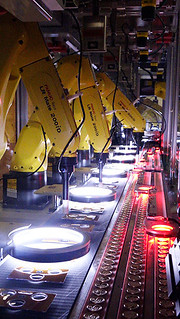
PREV ARTICLE
NEXT ARTICLE
FULL ISSUE
PREV FULL ISSUE
THE SAN FRANCISCO MINT ROBOTS
Young collectors are the future of our hobby, but the future is already here at the San Francisco Mint, This March 23, 2016 U.S. Mint
blog article by Adam Stump highlights the robots at work there. -Editor
The robots are part of the facility's Farason line, which was installed in 2010. The robotics loop, one of the cutting edge technologies used by the Mint, improving the quality and the rate of production for the sets San Francisco makes. The old line could produce at a rate of approximately 600 sets per hour. The new robotics loop triples that output at a rate of approximately 1,800 per hour. The Farason line has been busy in recent months making the last year of the Presidential $1 coin series. The Presidential $1 Coin Program, which started in 2007 and honored all deceased United States presidents, will come to an end in 2016 when the United States Mint at San Francisco mints the last coins. Packaging the 2016 coins once they've been minted, along with other proof sets made at the facility, falls to a series of robots tucked away in a corner of the San Francisco facility. “The robotic loop makes us a technology leader,” said Dave Jacobs, the plant manager. “The line helps package the coins for the largest producer of proof coins in the world, the United States Mint at San Francisco.” Justin Hatch, a packaging machine operator leader in San Francisco, explained each of the robots and their purpose. Robot 1 inspects the blister, or the pre-formed plastic insert. The robot picks up the blister and holds it against a tracking camera, which takes a picture and assigns a score to the item. If the score meets quality standards, the blister moves on. If there's a quality problem with the blister such as a scratch or crack, the item gets sent down a slide into a reject bin. Robot 2 takes off bottom trays and places them onto the belt. When this robot places the trays, it attempts to place them parallel to the belt. Robots 3 through 8 are called “pick and place robots.” Their job is to pick up coins and place them into the trays. If the item is a three coin set, only robots 3, 4 and 5 are working. The other three robots are used for sets that involve sets with four, five or six coins. Before each pick and place robot does their job, there's a tracking camera that is inspecting the packaging and taking a measurement of the orientation of the packaging. Since the packaging could slightly move, the inspection cameras tell the robots to change the orientation of the coin.
"Robot 3" sounds so ... robotic. You'd think they'd give them more colorful names, like "Kevin" or
"Rosie"... -Editor
To read the complete article, see:

Wayne Homren, Editor The Numismatic Bibliomania Society is a non-profit organization promoting numismatic literature. See our web site at coinbooks.org. To submit items for publication in The E-Sylum, write to the Editor at this address: whomren@gmail.com To subscribe go to: https://my.binhost.com/lists/listinfo/esylum All Rights Reserved. NBS Home Page Contact the NBS webmaster 
|
